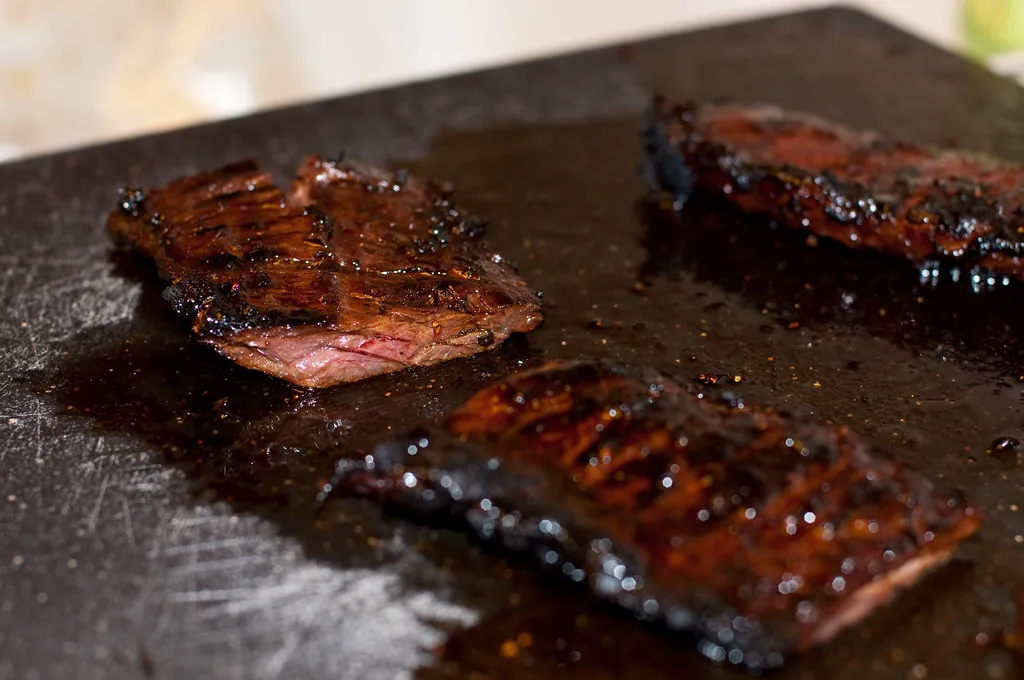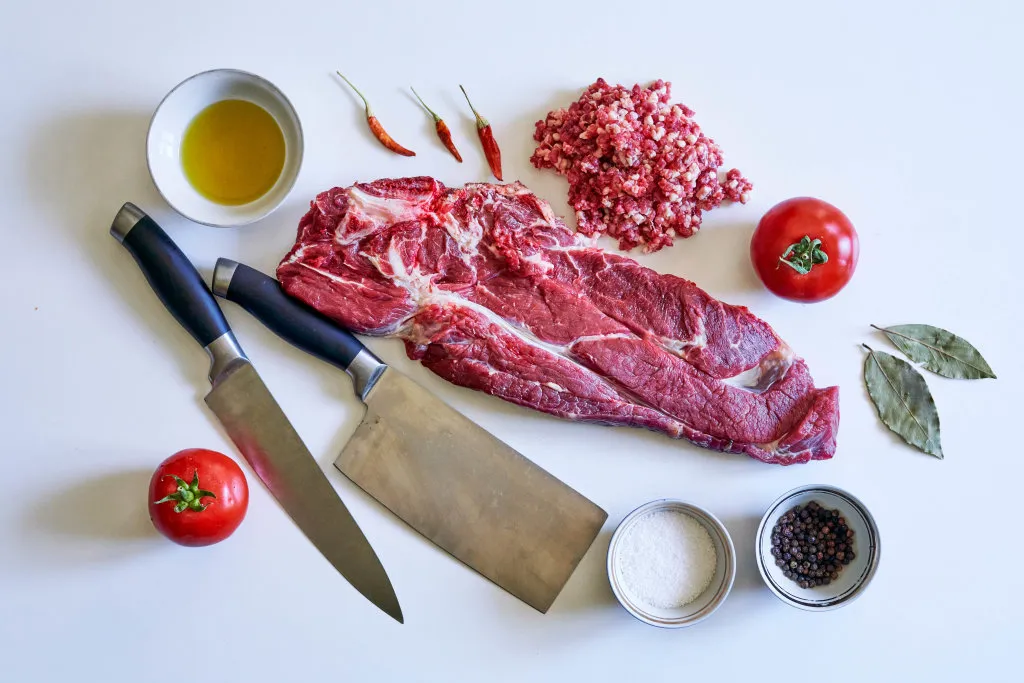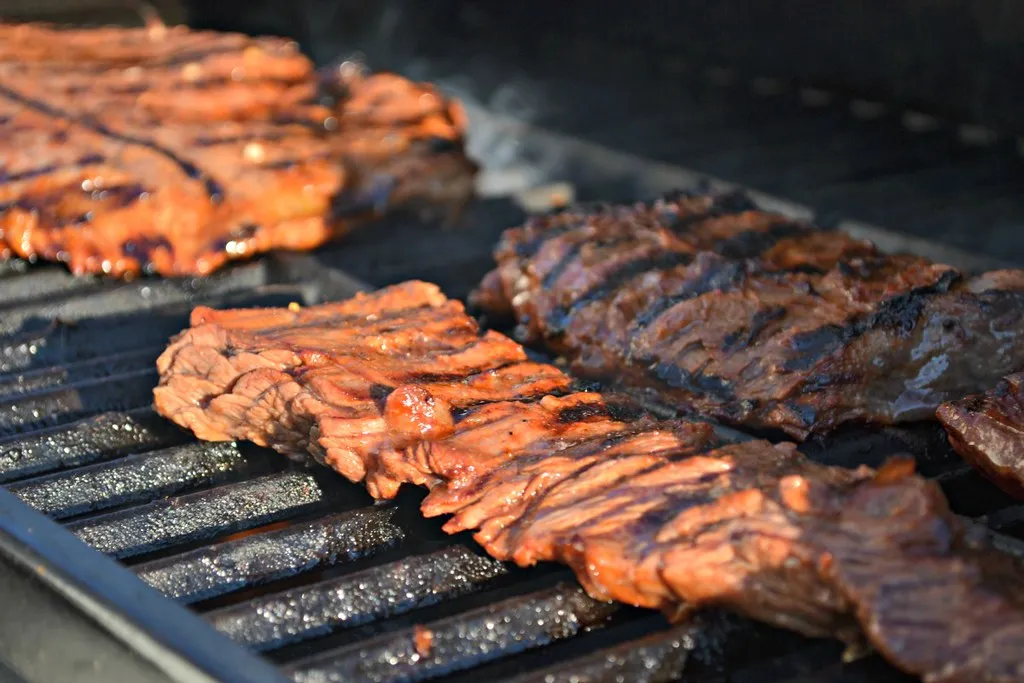The Best Fluffy Pancakes recipe you will fall in love with. Full of tips and tricks to help you make the best pancakes.
Skirt steak is a hidden gem in the world of beef cuts. Known for its rich flavor and tenderness, skirt steak is perfect for quick, budget-friendly meals. Whether grilling, pan-searing, or broiling, it’s versatile and easy to cook.
In this guide, we’ll teach you how to cook skirt steak perfectly. From selecting the right cut to choosing the best cooking method, we’ll cover it all. With simple techniques and seasoning tips, you’ll be enjoying a delicious skirt steak meal in no time. Ready to upgrade your weeknight dinners? Let’s dive into skirt steak!
What is Skirt Steak and Why Should You Cook It?
Skirt steak is a flavorful cut of beef known for its distinctive texture and rich, beefy taste. It comes from the diaphragm muscle of the cow, a part located near the abdomen. This cut is long, flat, and slightly fibrous, which gives it its unique chew and texture. Though it might seem tough at first glance, when cooked correctly, skirt steak can be incredibly tender and juicy.

Skirt Steak vs. Other Beef Cuts
When you compare skirt steak to other more well-known cuts like ribeye or sirloin, you’ll notice a few key differences. Unlike ribeye, which is tender due to its marbling, skirt steak has a leaner profile with a bolder beef flavor. Though it’s lower in fat, its unique texture and ability to absorb marinades make it ideal for fajitas, tacos, and stir-fries.
Skirt steak differs from flank steak, another abdominal cut. Flank steak is leaner and less flavorful. Skirt steak is more tender and has a stronger beefy taste, making it a popular choice for flavorful dishes.
Why Skirt Steak is Great for Home Cooking
One of the biggest reasons skirt steak is so popular for home cooking is its affordability. While cuts like ribeye and filet mignon can be quite pricey, skirt steak offers a budget-friendly option for those who want a steak experience without spending a fortune. Its relatively low cost and quick cooking time make it perfect for weeknight meals, especially when you’re craving something hearty and flavorful.
Additionally, skirt steak is incredibly versatile. It works well with many cooking methods, including grilling, pan-searing, and even broiling. Whether you like your steak with a crispy char or tender and juicy on the inside, skirt steak can deliver both with just the right technique. It’s also ideal for a variety of cuisines, including Tex-Mex, Asian, and Mediterranean dishes, adding versatility to your meal repertoire.
Key Attributes of Skirt Steak
Skirt steak is best known for its bold, beefy flavor. Unlike milder cuts like filet mignon, which are prized for their tenderness, skirt steak shines in dishes where its flavor can really take center stage. It has a unique texture that benefits from marinating and a quick, high-heat cook time, making it a favorite for grilling or stir-frying.
The key to cooking skirt steak well is to understand its structure. The muscle fibers run along the length of the cut, and slicing against the grain is essential for achieving a tender bite. When cooked correctly, skirt steak becomes tender, juicy, and full of flavor—making it a satisfying and cost-effective choice for beef lovers.
Why Should You Cook Skirt Steak?
Skirt steak should be on your radar because it provides an excellent combination of taste, texture, and value. It’s perfect for home cooks looking to create a delicious steak dish without breaking the bank. The fact that it can be prepared quickly—whether grilled, pan-seared, or broiled—makes it a go-to option for those with a busy lifestyle who still want a satisfying meal.
Additionally, skirt steak’s ability to take on bold marinades and seasonings means that you can customize the flavor to suit any dish. Whether you prefer smoky, spicy, or savory flavors, skirt steak is a fantastic canvas for experimenting with different seasonings and sauces.
How to Prepare Skirt Steak for Cooking
Preparing skirt steak properly is crucial to ensuring it turns out tender, juicy, and flavorful. While this cut of beef is relatively simple to cook, the right preparation steps will maximize its flavor and texture. From selecting the best skirt steak to marinating and seasoning, here’s everything you need to know about getting your skirt steak ready for the perfect cook.

Choosing the Right Skirt Steak
When it comes to skirt steak, not all cuts are created equal. The first step in preparation is selecting the right piece of meat. Skirt steak is often sold in two different types: inside skirt steak and outside skirt steak.
- Inside Skirt Steak: This cut is thinner and slightly less tender than the outside skirt steak, but still flavorful. It can sometimes be harder to find in stores.
- Outside Skirt Steak: This is the preferred cut for most recipes, as it’s thicker and tends to be more tender with a more intense flavor.
Look for skirt steak that is bright red in color with a marbled texture. The marbling of fat within the steak will help it stay juicy during cooking. If you’re unsure which cut to choose, ask your butcher for advice.
Another thing to keep in mind is the size. Skirt steak is often sold in long, thin strips, which can be quite large. Make sure the size matches your needs, but don’t worry if it looks a bit bigger than you expect—you can always cut it down to size after cooking.
Marinating Skirt Steak
Skirt steak is an ideal candidate for marinating, and doing so enhances both its flavor and tenderness. Since skirt steak can sometimes be tougher than other cuts, marinating helps break down the muscle fibers, making the steak more tender while infusing it with rich, savory flavors.
Here are some tips for marinating your skirt steak:
- Time: Allow the steak to marinate for at least 1 hour, but ideally, 4 to 6 hours in the fridge. If you’re in a rush, even a quick 30-minute marinade can enhance flavor, but longer marination results in a more deeply infused taste.
- Ingredients for Marinade: A basic marinade should contain acidic ingredients (such as lime or lemon juice, vinegar, or wine) to help tenderize the meat, oil (like olive oil) to help distribute flavors, and seasonings (garlic, onion, soy sauce, cumin, paprika, and chili powder). Adding a touch of honey or brown sugar can also help caramelize the steak when cooked.
- Avoid Over-Marination: While marinating for hours can improve the flavor, don’t marinate skirt steak for more than 12 hours, as the acid in the marinade can start to break down the meat too much and make it mushy.
A popular marinade for skirt steak includes soy sauce, garlic, lime juice, and a bit of brown sugar for sweetness. Combine these ingredients and pour them over the steak in a resealable plastic bag or shallow dish. Be sure to coat the meat thoroughly.
Seasoning Tips
In addition to marinating, seasoning is another important step in preparing skirt steak. The goal is to balance the bold beef flavor with seasoning that enhances, rather than overpowers, the meat’s natural taste.
- Salt and Pepper: The simplest way to season skirt steak is by using kosher salt and freshly cracked black pepper. Apply these generously just before cooking for maximum flavor. The salt will draw out moisture, creating a savory crust during cooking.
- Dry Rubs: For an extra punch of flavor, you can apply a dry rub to the skirt steak. Combine ingredients like garlic powder, onion powder, paprika, chili powder, and cumin for a smoky, spicy kick. Dry rubs add depth and create a flavorful crust when seared.
- Herbs: If you’re looking for a more aromatic seasoning, fresh herbs like rosemary or thyme can be added to your marinade or sprinkled on the steak just before cooking. Cilantro is also a great herb for pairing with skirt steak, especially if you’re making tacos or fajitas.
- Resting Time: Once you’ve seasoned your steak, let it sit at room temperature for about 20 to 30 minutes before cooking. This allows the meat to absorb the seasonings and ensures even cooking.
Resting Time Before Cooking
It might sound counterintuitive, but letting your skirt steak rest at room temperature before cooking is an important step. Cold steak straight from the fridge will cook unevenly, and it can also cause the muscle fibers to seize up, resulting in a tougher texture. By letting the steak rest for 20 to 30 minutes, you allow it to warm up slightly, which helps with even cooking and results in a tender, juicy steak.
Prepping Your Equipment
While preparing your skirt steak, don’t forget to prep your cooking equipment:
If you’re grilling, make sure the grill is preheated to high heat. A Ninja Grill is a great option for smokeless indoor grilling with interchangeable plates and easy cleanup.
A cast-iron skillet works beautifully for pan-searing and should be heated on the stovetop until it’s smoking hot.
Have your meat thermometer ready if you want to check doneness, though the quick searing method means it’s often best to rely on timing and touch. A pair of tongs or a spatula is also helpful for flipping the steak without piercing it.
Skirt Steak Cooking Methods: Grilling, Pan-Searing, and More
Skirt steak is an incredibly versatile cut of beef, and it can be cooked in several ways to bring out its bold flavor and tender texture. Whether you’re firing up the grill, using a cast-iron skillet on the stovetop, or broiling it in the oven, the method you choose will impact the final result. Let’s explore the most popular cooking methods for skirt steak and how to get the best results.

Grilling Skirt Steak
Grilling is arguably the most popular method for cooking skirt steak, and for good reason. The high heat of the grill creates a beautifully charred exterior, which enhances the steak’s natural flavors while keeping the inside juicy and tender.
- Preheat the Grill: Before cooking, make sure your grill is preheated to high heat (around 450°F to 500°F). Skirt steak cooks quickly, and you want the grill to be hot enough to sear the meat properly without overcooking it.
- Direct Heat: Skirt steak should be cooked over direct heat. Place the marinated or seasoned steak on the grill and close the lid. Grill for 3 to 4 minutes per side for medium-rare, or adjust the time slightly for more or less doneness. Keep an eye on the steak, as skirt steak cooks very quickly.
- Doneness Check: For the best results, use a meat thermometer to check doneness, aiming for an internal temperature of 130°F for medium-rare. Skirt steak is best when it’s cooked to no more than medium, as it can become tough and chewy if overcooked.
- Resting Time: Once off the grill, let the skirt steak rest for about 5 to 10 minutes before slicing. This allows the juices to redistribute, keeping the steak moist.
Grilling is a great method for getting that smoky, charred flavor, which pairs perfectly with a variety of marinades, like a zesty lime-based or smoky chipotle marinade.
Pan-Searing Skirt Steak
If you don’t have access to a grill, pan-searing is an excellent alternative. This method gives you a beautifully browned crust and a juicy interior, making it ideal for a quick, flavorful steak dinner.
- Choose the Right Pan: Use a cast-iron skillet or a heavy-duty non-stick skillet. Cast-iron pans are perfect for searing because they retain and distribute heat evenly, giving your steak a nice crispy crust.
- Heat the Pan: Preheat your pan over high heat until it’s smoking hot. Add a small amount of oil with a high smoke point (like vegetable oil or canola oil). The oil will help create a sear without burning.
- Searing the Steak: Place the skirt steak in the pan and let it sear without moving it for about 2 to 3 minutes per side. This will develop a deep, golden-brown crust. Use tongs to flip the steak and avoid piercing it, which would release juices.
- Optional Butter Basting: For extra flavor, you can add a tablespoon of butter, along with some garlic cloves and fresh thyme or rosemary, to the pan after flipping the steak. As the butter melts, spoon it over the steak to add richness and a beautiful aroma.
- Internal Temperature: Use a thermometer to ensure the steak reaches 130°F for medium-rare. If you don’t have a thermometer, another way to check doneness is to gently press the steak with your finger—medium-rare will feel like the fleshy part of your hand under your thumb.
- Resting Time: Once done, remove the steak from the skillet and let it rest for 5 minutes before slicing.
Pan-searing works particularly well if you prefer a crusty exterior and a tender, juicy interior, especially when paired with complementary sauces like chimichurri or garlic butter.
Broiling Skirt Steak
Broiling is another quick method to cook skirt steak indoors. The broiler mimics the effect of grilling by exposing the meat to high, direct heat from above, creating a beautifully caramelized crust.
- Preheat the Broiler: Set your oven’s broiler to high and let it preheat for 5 minutes. Position the oven rack about 6 inches from the heating element.
- Prepare the Steak: Place the skirt steak on a broiler pan or a wire rack set over a baking sheet. This allows air to circulate around the meat, helping it cook evenly.
- Broil the Steak: Place the pan in the oven and broil the steak for 3 to 4 minutes per side for medium-rare, or adjust the time depending on your desired doneness. Broiling cooks the steak quickly, so keep a close eye on it to avoid overcooking.
- Doneness Check: Use a meat thermometer to check the internal temperature, aiming for 130°F for medium-rare. This ensures the steak is cooked just right, with a caramelized exterior and a tender, juicy interior.
- Resting Time: After broiling, let the steak rest for 5 to 10 minutes to retain its juices.
Broiling is perfect if you’re looking for a simple, fuss-free cooking method that delivers delicious results without having to stand over a hot grill or stovetop. It’s a great option for an easy, flavorful meal when you’re in a time crunch.
Sous-Vide Cooking for Skirt Steak (Optional)
For those who want precise control over doneness, sous-vide is a method worth considering. It involves cooking the steak in a water bath at a precise temperature for a long period, ensuring a perfectly even cook from edge to edge.
- Prepare the Steak: Season the skirt steak with your preferred seasonings or marinade, then vacuum-seal it in a sous-vide bag. If you don’t have a vacuum sealer, a zipper-lock bag with the air removed can also work.
- Set the Sous-Vide Precision Cooker: Set your sous-vide machine to the desired temperature. For medium-rare skirt steak, set the water bath to 130°F.
- Cooking Time: Cook the steak in the water bath for 1 to 2 hours. Since sous-vide cooking is very forgiving, you can even leave the steak in the water for a bit longer if necessary.
- Finishing the Steak: After sous-vide cooking, remove the steak from the bag, pat it dry, and quickly sear it on a hot pan or grill for 30 seconds per side to develop a crust.
Sous-vide ensures that your skirt steak is cooked precisely to the desired level of doneness, resulting in a perfectly tender and juicy steak with minimal effort.
Choosing the Right Cooking Method for Your Skirt Steak
Each of these cooking methods brings out a different characteristic of skirt steak. Grilling offers a smoky charred flavor, pan-searing gives you a rich crust with a juicy interior, and broiling is perfect for cooking indoors with less mess. Sous-vide, on the other hand, offers unparalleled control over doneness for those who prefer precision.
No matter which method you choose, remember that skirt steak is best when cooked quickly over high heat. Overcooking it will lead to a tough and chewy texture, so aim for a medium-rare to medium cook to ensure optimal flavor and tenderness.
Serving Skirt Steak: Slicing, Pairing, and Meal Ideas
Once your skirt steak is cooked to perfection, serving it correctly can elevate the dining experience. Skirt steak is not only flavorful but also versatile, making it an excellent choice for a variety of meals. From how to slice it to the best side dishes to pair with it, this section will guide you through the steps to serve your skirt steak in the most delicious and visually appealing way.
How to Slice Skirt Steak for Maximum Tenderness
Properly slicing skirt steak is crucial for achieving a tender and enjoyable bite. Unlike other cuts of beef, skirt steak has long muscle fibers, so cutting against the grain is essential to avoid a tough, chewy texture.
- Identify the Grain: Skirt steak has a noticeable grain, which refers to the direction of the muscle fibers. The grain usually runs lengthwise, so look for the lines of muscle fibers running in one direction.
- Slice Against the Grain: To maximize tenderness, slice the skirt steak across the grain, or perpendicular to those muscle fibers. This breaks up the fibers and makes each bite easier to chew. A good rule of thumb is to cut the steak into 1/4-inch to 1/2-inch slices.
- Angle Your Knife: For an even more tender result, use a sharp knife and cut at a slight angle. Cutting at an angle helps produce wider slices, which feel more tender and appealing.
- Resting Time: After removing the steak from the heat source, let it rest for about 5 to 10 minutes before slicing. This allows the juices to redistribute throughout the meat, ensuring the steak stays juicy when cut.
Pairing Skirt Steak with Side Dishes
Skirt steak is a bold and flavorful cut of meat, and pairing it with the right side dishes can elevate your meal to new heights. Whether you’re in the mood for a comforting classic like potatoes or something fresher like a vibrant salad, the right accompaniments can balance out the richness of the steak and enhance its savory flavor.
Grilled Vegetables
The smoky flavors of grilled vegetables create a perfect contrast to the rich, beefy taste of skirt steak. Veggies like asparagus, bell peppers, zucchini, or mushrooms are excellent choices. Grilling brings out their natural sweetness, and the caramelization adds depth that complements the savory steak. Simply toss the vegetables in olive oil, salt, and pepper before grilling for a simple yet flavorful side.
Potatoes
Potatoes are a classic pairing with skirt steak, offering a hearty and comforting side. Try crispy roasted potatoes, creamy garlic mashed potatoes, or indulgent twice-baked potatoes for a satisfying meal. The mild richness of the potatoes perfectly balances the robust flavor of the steak. If you’re looking for something lighter, a tangy potato salad or smashed potatoes with mustard dressing provides acidity that cuts through the steak’s richness.
Fresh Salads
To bring a refreshing contrast to the heavy flavors of skirt steak, serve it with a fresh green salad. A simple arugula salad with balsamic vinaigrette or a zesty Greek salad with feta, olives, and cucumber will provide a crisp, vibrant contrast. The acidity from the salad dressing helps to balance the richness of the steak, offering a perfect harmony of flavors.
Rice or Grains
For a more substantial side, pair your skirt steak with rice, quinoa, or couscous. These grains soak up the juices from the steak and add a satisfying texture to the meal. For an extra burst of flavor, try cilantro-lime rice or garlic-infused quinoa—perfect companions for skirt steak, especially if the steak is seasoned with a Latin-inspired marinade.
Sauces
Enhancing your skirt steak with a delicious sauce can take the dish to the next level. Consider a tangy chimichurri sauce, with its vibrant mix of parsley, garlic, and vinegar, which pairs wonderfully with grilled meats. For something more indulgent, try a rich béarnaise sauce or a garlic butter sauce to complement the steak’s savory flavor. If you enjoy a little heat, a spicy sriracha mayo or chipotle aioli will add a flavorful kick to the meal.
Creative Garnishes and Finishes
To elevate the presentation and flavor of your skirt steak, consider adding a few creative garnishes:
- Crispy Fried Onions: For a crunchy texture, top your skirt steak with crispy fried onions or onion rings.
- Fresh Herbs: A sprinkle of fresh herbs, such as parsley, cilantro, or thyme, can add a pop of color and fresh flavor.
- Lemon Zest or Lime Wedges: A squeeze of citrus right before serving brightens the steak and adds a refreshing contrast to the richness.





